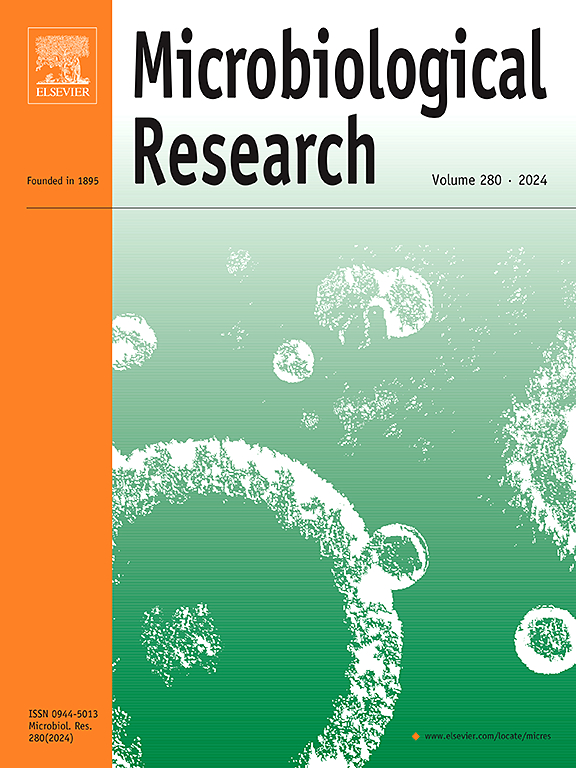Bacterial and fungal diversity and species interactions inversely affect ecosystem functions under drought in a semi-arid grassland
IF 6.1
1区 生物学
Q1 MICROBIOLOGY
引用次数: 0
Abstract
Extreme climatic events, such as drought, can significantly alter belowground microbial diversity and species interactions, leading to unknown consequences for ecosystem functioning. Here, we simulated a drought gradient by removing 30 %, 50 %, and 70 % of precipitation in a semi-arid grassland over five years. We assessed the effects of drought on bacterial and fungal diversity, as well as on their species interactions. We also evaluated the impact of drought on ecosystem individual functions (e.g., plant biomass and microbial activity), and on multifunctionality (EMF). Finally, we linked the drought-induced changes in microbial communities with the variations in EMF. Drought significantly increased fungal diversity and intensified species interactions, but it decreased bacterial diversity and species interactions. Both plant and microbial biomass significantly decreased with increasing drought severity, while microbial activity showed the opposite trend. Only the −50 % rainfall treatment notably reduced EMF. Bacterial diversity and species interactions positively correlated with most ecosystem functions. However, fungal parameters were negatively associated with these functions. Structural equation modeling indicated that bacterial diversity had a strong direct positive effect on EMF (standardized path coefficient: 0.52), and that bacterial diversity was indirectly suppressed by drought through decreasing soil water content and bacterial phospholipid fatty acids (PLFAs). In contrast, fungal species interactions had a significant direct negative effect on EMF with the highest standardized path coefficient (−0.6) and were directly enhanced by fungal diversity. Drought had indirect positive effects on fungal diversity by decreasing soil water content and stimulating fungal PLFAs. Our results highlight the importance of considering soil microbial species interactions when evaluating the ecological impacts of drought. Furthermore, the divergent regulatory pathways of bacterial and fungal communities to EMF suggest that improving ecosystem functionality may be achieved by enhancing bacterial diversity while mitigating fungal species interactions through reducing fungal diversity.
干旱条件下半干旱草地细菌和真菌多样性及物种间相互作用对生态系统功能产生负向影响。
干旱等极端气候事件可显著改变地下微生物多样性和物种相互作用,对生态系统功能造成未知后果。在这里,我们模拟干旱梯度去除30 %,50 %和70 %的降水在半干旱草地超过五年。我们评估了干旱对细菌和真菌多样性的影响,以及它们的物种相互作用。我们还评估了干旱对生态系统个体功能(如植物生物量和微生物活动)和多功能性(EMF)的影响。最后,我们将干旱引起的微生物群落变化与EMF变化联系起来。干旱显著增加了真菌多样性和物种间的相互作用,但降低了细菌多样性和物种间的相互作用。随着干旱程度的增加,植物生物量和微生物生物量均显著降低,而微生物活性呈相反趋势。只有-50 %的降雨处理显著降低了EMF。细菌多样性和物种相互作用与大多数生态系统功能正相关。然而,真菌参数与这些功能呈负相关。结构方程模型表明,细菌多样性对土壤EMF具有强烈的直接正向影响(标准化通径系数为0.52),干旱通过降低土壤含水量和细菌磷脂脂肪酸(PLFAs)间接抑制细菌多样性。真菌物种间相互作用对EMF有显著的直接负向影响,其标准化通径系数最高(-0.6),真菌多样性直接增强了EMF。干旱通过降低土壤含水量和刺激真菌PLFAs对真菌多样性有间接的积极影响。我们的研究结果强调了在评估干旱的生态影响时考虑土壤微生物物种相互作用的重要性。此外,细菌和真菌群落对EMF的不同调节途径表明,改善生态系统功能可能通过增强细菌多样性来实现,同时通过减少真菌多样性来减轻真菌物种的相互作用。
本文章由计算机程序翻译,如有差异,请以英文原文为准。
求助全文
约1分钟内获得全文
求助全文
来源期刊

Microbiological research
生物-微生物学
CiteScore
10.90
自引率
6.00%
发文量
249
审稿时长
29 days
期刊介绍:
Microbiological Research is devoted to publishing reports on prokaryotic and eukaryotic microorganisms such as yeasts, fungi, bacteria, archaea, and protozoa. Research on interactions between pathogenic microorganisms and their environment or hosts are also covered.
 求助内容:
求助内容: 应助结果提醒方式:
应助结果提醒方式:


